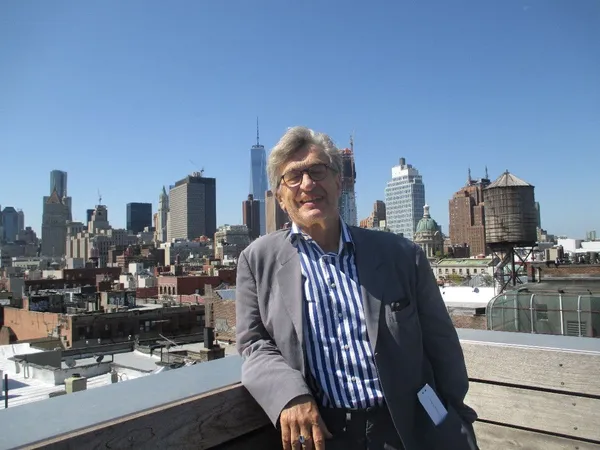 |
| 2016 marks the 25th anniversary of Wim Wenders' masterwork Until the End of the World. Photo: Anne-Katrin Titze |
Sam Shepard's influence before he worked with Volker Schlöndorff on Max Frisch's Homo Faber (Voyager), Peter Carey and the script, Yasujiro Ozu actors Chishû Ryû and Kuniko Miyake, Alfred Hitchcock's Vertigo and The Man Who Knew Too Much, Chen Kaige, Robby Müller and Vermeer, Yohji Yamamoto, Notebook on Cities and Clothes, Lord Byron and much more are inspected here.
Until The End Of The World stars Solveig Dommartin, Max von Sydow, William Hurt, Jeanne Moreau, Rüdiger Vogler and Sam Neill and an extraordinary soundtrack featuring Nick Cave and the Bad Seeds, U2, Julee Cruise, Peter Gabriel, Lou Reed, Crime and the City Solution, Neneh Cherry, R.E.M., Patti Smith, Daniel Lanois, T-Bone Burnett, Elvis Costello, Jane Siberry, k.d. lang with uncredited performances by David Byrne with Talking Heads, Tom Waits and Tom Farrell as the Madman in the bar.
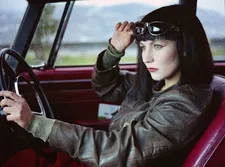 |
| Solveig Dommartin as Claire Tourneur |
Until The End Of The World (Bis Ans Ende Der Welt) in all its "director's cut" glory keeps hold of the key to movie travel fantasies that drive Wim Wenders. Set in a futuristic 1999, a nuclear satellite is out of control and threatening life on earth. The future is now the past and, surprisingly, even more than the technology predicted by the film, such as video phones, cars with speaking GPS and addictive handheld devices, it is the body language, the absorbed zombie stares into the screens of the little gadgets that is chilling to the bone in its clairvoyance.
The ultimate road trip begins with a beguiling party in 1999 Venice, where in a beautiful palazzo we first meet Claire Tourneur (Solveig Dommartin) sporting an Anna Karina hairstyle and a dress with shingle layers like armor. Claire, apparently bored by her idle life, hits the road back home to Paris where she intends to move out of the apartment she shares with her boyfriend Eugene Fitzpatrick (Sam Neill), a writer and the narrator of the movie.
A decision in the car to alter her course turns her life around - "all our lives," Eugene, in voiceover, knows. Claire encounters on the road first Chico (Chick Ortega) and Raymond (Eddy Mitchell) who could be angels or assassins, and then a mysterious man with an alias, who turns out to be Sam Farber (William Hurt), son of renowned scientist Henry Farber (Max von Sydow) who is on a very special, groundbreaking quest.
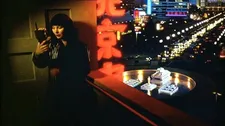 |
| Claire in Until The End Of The World: "We invented this whole narcissistic culture of looking at yourself." |
From Paris to Berlin to Lisbon to Moscow to China to Japan to San Francisco, each location transformed in killer-coloured, past and future combining, set design, we travel with Claire and her men in various constellations of a detective plot (with Rüdiger Vogler perfecting his multi-movie Phillip Winter character) until in the second half of the story, we turn inward in Australia, and Jeanne Moreau as Edith Farber leads us into a cave in the desert, a dreamworld laboratory, that is as enticing as it is dangerous.
Wim Wenders: Portraits Along The Road, a major retrospective of his films is on tour now, which includes the director's cut of Until The End Of The World. Read our conversation on his latest Peter Handke collaboration, The Beautiful Days Of Aranjuez (Les Beaux Jours D’Aranjuez).
Anne-Katrin Titze: I saw Until The End Of The World [the European cut at 2:59] in Paris in 1991 and remember liking it very much even then. You called that a butchered version. When I saw the director's cut [4:49], it was a peculiar experience. It felt as though I had been dreaming parts of it, which is very fitting with the subject matter. How does the film feel to you now, presenting your version to audiences?
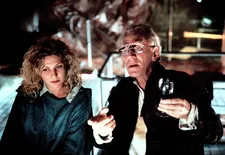 |
| Claire with Henry Farber (Max von Sydow): "Yeah, and it's no wonder that you have that feeling that you're dreaming." |
Wim Wenders: I'm so happy that a quarter of a century later, I can actually show what this most ambitious project of mine was all about and why it was so expensive. It cost 24 million dollars. For an auteur movie at the time it was ridiculous. I don't think ever any independent production at the time cost that much. I owed it to the actors who had really for one year worked their asses off.
And these musicians who contributed to the film, who all threw themselves into the future with us and wrote a song that they projected themselves with into the year 2000. That was, of course, all in 1990. I'm so happy that I can finally show what we really meant and what the scope of the film was, the scope of the idea was. At the time, especially the dream part, was pretty radically shortened.
AKT: Shortened?
WW: Yeah, and it's no wonder that you have that feeling that you're dreaming. Because the film is very much about dreaming and about how we perceive our dreams. At the time it was really meant as a film about the future of our visual language. We sort of projected the internet and we projected all those little hand-held devices.
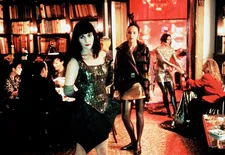 |
| Solveig Dommartin in a metallic dress: "It was hell to wear and hell to put together." |
AKT: Yours were a bit thicker. That's the only difference.
WW: They needed to work and screens were not available that were so flat and so thin. But we invented this whole narcissistic culture of looking at yourself. I think we anticipated the selfie culture. Watching your dreams is about that.
AKT: You have lines in the film that speak of this. "Their days became black holes of isolation." The only thing they care about are fresh batteries to keep the device going. That is the world we live in now. Even the way they hold their heads looking at the screens. I think that was most interesting - the body language you anticipated.
WW: Our actors were able to live long enough with these little instruments to anticipate even how we would use them in the end. It was truly science fiction at the time. It's sort of strange to now be able to verify it and see that we were right on the money with some of it. And some, of course, is still science fiction. We can still not actually look at our dreams but, in a way, that was only a metaphor for the self-involvement. Seeing your own image - finally that's what our selfie culture is all about.
 |
| Wim Wenders' Notebook On Cities And Clothes: "Yohji Yamamoto designed a lot of the wardrobes." |
AKT: It made me think of Things To Come, the film by William Cameron Menzies, based on the H.G. Wells novel. It was made in 1936 and anticipated the war starting in 1940. Watching it produced a similar time shock in me. I had to go back and check when exactly it was made. It's the opposite of futur antérieur. What do you call that? What will have been in the future as opposed to what is still not yet in the past? Can you talk about the concept of time for the film?
WW: Well, the concept of the future is so much linked in every science fiction movie to the time it is made. It is really about what at a certain time you want from the future or what you desire from the future or what you're afraid about in the future. So Until the End of the World is also very much about the1990s and the anticipation of the new century and the idea that there was a whole new visual culture coming towards us. It was going to be called "digital" but we had no clue what it was all about. So it was sort of extrapolating things we knew.
AKT: The film begins in Venice. The place, the party scene - the visuals are fascinating. They are not the 1990s, really. I have to compliment you on the fantastic sets in this film. There's nothing like it.
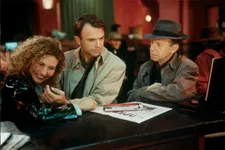 |
| Claire with Eugene Fitzpatrick (Sam Neill) and Phillip Winter (Rüdiger Vogler) |
WW: Oh, we had a great art department. And especially in the beginning when we still had money. Towards the end we were running out. The beauty of this party is that the palace itself was so unbelievable. It is a place where Lord Byron lived in Venice. He, in the end, was the ultimate traveler. That's why I chose Venice and that's why I chose this place to sort of get Lord Byron into the boat.
AKT: You didn't do it in Lisbon. In Sintra there's a park Lord Byron wrote about. You know the one I am talking about?
WW: Yes. We didn't really get to Sintra. We only shot inside Lisbon.
AKT: The colour scheme for me did not time stamp the film as early Nineties.
WW: Well, of course you have the Nineties come through in city streets, in traffic and stuff. We tried to surround our characters as much as possible. All of the cars you see are either very old cars, which we figured were always going to be fancy, or were prototypes. We got a lot of prototype cars from car companies. And a big attention we paid to wardrobe because wardrobe seemed like such a big part of what we are going to be like years from then. So all our actors were wearing a wardrobe that didn't exist at that time.
_225.webp) |
| Claire with Sam Farber aka Trevor McPhee (William Hurt) |
AKT: Solveig [Dommartin] is dressed in colors of metal often. Some dresses look like armour.
WW: It was actually some strange 3D pellets that reflected in all sorts of colors and have a three dimensional holographic effect. It was hell to wear and hell to put together because we had to sew a maze of those little pieces together. Yohji Yamamoto designed a lot of the wardrobes for the leading actress and the two leading men [William Hurt and Sam Neill].
AKT: Had you made your Yamamoto film [Notebook on Cities and Clothes] before this one?
WW: Yes, just before. And I think the Yamamoto film was quite influential in the end on the look of Until The End Of The World.
AKT: I could see it especially in the men's suits. The brown suit that is all one color with the vest and the shirt.
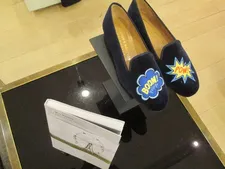 |
| Wim Wenders - Places, strange and quiet Photo: Anne-Katrin Titze |
WW: Oh yes, that's a beauty! That was a beauty. We had several of them because he [Hurt] was practically wearing it every day in every scene. Even in the desert. It was pretty much worn out. We were happy that we had three of them because all three of them were pretty disheveled at the end.
AKT: The suit seems to be part of the End Of The World fantasy. After the nuclear blast, everything is pared down and minimal. They don't know if the rest of the world is still alive.
WW: They just had what they had on their bodies. It's really two journeys. The first part of the film which is quite an extravagant road movie around the world. And the second one which is really a journey into the interior and deeper and deeper into this laboratory, into this secluded place in the middle of nowhere, deep in Australia.
AKT: The scenes in Japan, I felt, are at the heart of the film. First of all, it's wonderful to see the two great Ozu actors [Chishû Ryû and Kuniko Miyake]. Also there are very important lines that tell us a lot about the characters. About Claire we hear: "For the first time she was fulfilled. For the first time she was of service." That's important to understand her character.
 |
| Wim Wenders: Portraits Along The Road at IFC Center Photo: Anne-Katrin Titze |
WW: For her character this is very important. See, her character suffered a lot in the reader's digest version because in that version we also had to cut the narrator. There was no narrator. Eugene's part was almost not there in the reader's digest version. To have this writer accompany the story with his narration so much gave it more texture and helped especially the part of Solveig so much. She was sometimes in the short version really abandoned by her two men, both Eugene [Sam Neill] and Sam [William Hurt]. The film has so much more texture now. Now that I own the film in the Foundation, we really stopped the distribution of the short version because it was just not the film I wanted to make.
AKT: I must admit that I was curious to know what of it I actually saw. The other line that struck me during the scenes in Japan is what William Hurt's character says: "All I want is for my mother to see and for my father to know that I love him." What a line! I wrote down in my notebook while watching, "Don't we all?" Isn't that the most universal thing to want?
WW: That's why I arrived at that scene in Japan. Especially when they stay at the ryokan and recover from their exhaustion, is really the anchor point of the entire film. That's where their relationship comes together. And that's where we understand finally who those people are that we followed so far.
Wim Wenders: Portraits Along The Road, the retrospective in 2016, continues on tour to Minneapolis, Atlanta, Seattle and Portland, after opening at the IFC Center in New York in 2015, and stops along the way in Chicago, Amherst, Vancouver, Los Angeles, San Francisco, Cleveland, Nashville and Cambridge, Massachusetts.
Coming up in our conversation - San Francisco and Alfred Hitchcock, creating a Vermeer setting with cinematographer Robby Müller, Peter Carey and the script, Elvis Presley and the soundtrack, Max von Sydow and William Hurt as father and son, Jeanne Moreau enters the picture, Greenspace, Chen Kaige. Sam Shepard and Sam Farber, Volker Schlöndorff and Max Frisch's Homo Faber (Voyager).





















